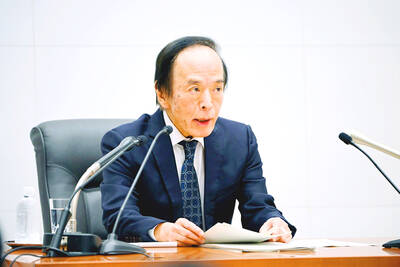Contract electronics manufacturer Pegatron Corp (和碩) yesterday said that it has begun exploring overseas expansion options to cope with escalating US-China trade tensions.
The company is to reallocate production from China to its existing sites in the Czech Republic and Mexico as it reviews its global footprints, Pegatron chief executive officer S.J. Liao (廖賜政) told an investors’ teleconference, adding that it is also considering setting up new manufacturing bases in Southeast Asia.
Although reallocating production capacity and moving equipment between the company’s locations would not require substantial capital expenditure, the change would push up management costs, Liao said.
Setting up brand new production lines in Southeast Asia would be costlier and it would take two to three years before such facilities would come online, he added.
“We will be talking with our customers about sharing the burden of additional costs,” Liao said.
US President Donald Trump’s looming tariffs on US$260 billion of Chinese-made goods are not the only reason for the company to diversify its production, Liao said, adding that the entire supply chain is challenged by labor shortages and rising wages in China.
Diversification would also help push down the cost and difficulty of gathering the required workforce during peak seasons, Liao said.
To avoid US tariffs, products made outside China must meet country-of-origin requirements, which stipulate that 30 to 35 percent of the value of an exported product must be derived locally, Pegatron chief financial officer Charles Lin (林秋炭) said.
That could be more difficult for electronics assemblers, which rely on key components from China’s well-established supply chains and industry hubs, Lin said, adding that it would take until next year for the effects of trade tensions on demand to materialize.
Lin rejected reports suggesting that Apple Inc has cut iPhone XR orders from Pegatron and other suppliers due to lower-than-expected demand, saying that the company’s strong performance last month showed that the ongoing peak season has met expectations.
Pegatron’s plants have been running at full capacity, he said.
The company reported that revenue last month rose 55.1 percent monthly and 11.7 percent annually to NT$186.02 billion (US$6.06 billion), a new monthly high.
Pegatron previously reported that net income in the third quarter rose 5.1 percent quarter-on-quarter, but dropped 31.9 percent from the same period last year due to rising component and labor costs, as well as a delayed production ramp-up.
Net income was also dragged down by NT$140 million in foreign-exchange losses, down from gains of NT$1.01 billion in the previous quarter. Earnings per share were NT$1.08.
Revenue last quarter rose 18.7 percent sequentially, but dipped 4.4 percent from the same period last year to NT$322 billion.
Gross margin inched up from 3.2 percent at the end of June to 3.3 percent at the end of September, while operating margin rose to 1.1 percent from 0.6 percent in the second quarter.

Taiwan Semiconductor Manufacturing Co (TSMC, 台積電) last week recorded an increase in the number of shareholders to the highest in almost eight months, despite its share price falling 3.38 percent from the previous week, Taiwan Stock Exchange data released on Saturday showed. As of Friday, TSMC had 1.88 million shareholders, the most since the week of April 25 and an increase of 31,870 from the previous week, the data showed. The number of shareholders jumped despite a drop of NT$50 (US$1.59), or 3.38 percent, in TSMC’s share price from a week earlier to NT$1,430, as investors took profits from their earlier gains

In a high-security Shenzhen laboratory, Chinese scientists have built what Washington has spent years trying to prevent: a prototype of a machine capable of producing the cutting-edge semiconductor chips that power artificial intelligence (AI), smartphones and weapons central to Western military dominance, Reuters has learned. Completed early this year and undergoing testing, the prototype fills nearly an entire factory floor. It was built by a team of former engineers from Dutch semiconductor giant ASML who reverse-engineered the company’s extreme ultraviolet lithography (EUV) machines, according to two people with knowledge of the project. EUV machines sit at the heart of a technological Cold

TAIWAN VALUE CHAIN: Foxtron is to fully own Luxgen following the transaction and it plans to launch a new electric model, the Foxtron Bria, in Taiwan next year Yulon Motor Co (裕隆汽車) yesterday said that its board of directors approved the disposal of its electric vehicle (EV) unit, Luxgen Motor Co (納智捷汽車), to Foxtron Vehicle Technologies Co (鴻華先進) for NT$787.6 million (US$24.98 million). Foxtron, a half-half joint venture between Yulon affiliate Hua-Chuang Automobile Information Technical Center Co (華創車電) and Hon Hai Precision Industry Co (鴻海精密), expects to wrap up the deal in the first quarter of next year. Foxtron would fully own Luxgen following the transaction, including five car distributing companies, outlets and all employees. The deal is subject to the approval of the Fair Trade Commission, Foxtron said. “Foxtron will be

INFLATION CONSIDERATION: The BOJ governor said that it would ‘keep making appropriate decisions’ and would adjust depending on the economy and prices The Bank of Japan (BOJ) yesterday raised its benchmark interest rate to the highest in 30 years and said more increases are in the pipeline if conditions allow, in a sign of growing conviction that it can attain the stable inflation target it has pursued for more than a decade. Bank of Japan Governor Kazuo Ueda’s policy board increased the rate by 0.2 percentage points to 0.75 percent, in a unanimous decision, the bank said in a statement. The central bank cited the rising likelihood of its economic outlook being realized. The rate change was expected by all 50 economists surveyed by Bloomberg. The